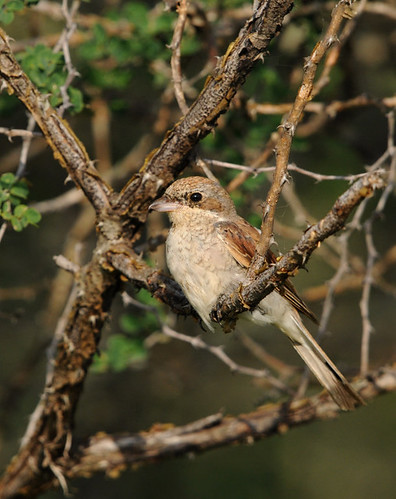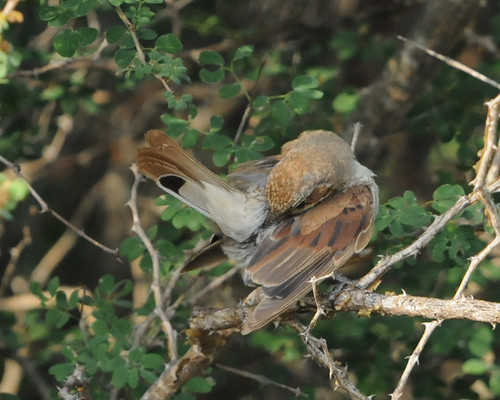tags: Red-backed Shrike, Lanius collurio, birds, mystery bird, bird ID quiz
[Mystery bird] Juvenile Red-backed Shrike, Lanius collurio, photographed about 5 miles away from the Pangani River Camp, Tanzania, Africa. [I will identify this bird for you in 48 hours]
Image: Dan Logen, January 2010 [larger view].
Nikon D300 600 mm lens, ISO 400, 1/1250 sec, f/7.1 -1 exposure compensation.
Please name at least one field mark that supports your identification.
Photograph 1:
[Image 1] Juvenile Isabelline Shrike (?), Lanius isabellinus, photographed about 5 miles away from the Pangani River Camp, Tanzania, Africa. [I will identify this bird for you in 48 hours]
Image: Dan Logen, January 2010 [larger view].
Nikon D300 600 mm lens, ISO 400, 1/1250 sec, f/7.1 -1 exposure compensation.
Photograph 2:
[Image 2] Juvenile Isabelline Shrike (?), Lanius isabellinus, photographed about 5 miles away from the Pangani River Camp, Tanzania, Africa. [I will identify this bird for you in 48 hours]
Image: Dan Logen, January 2010 [larger view].
Nikon D300 600 mm lens, ISO 400, 1/1250 sec, f/7.1 -1 exposure compensation.




ah, the predatory nature of that slightly hooked beak tends to one of the fourteen species in that family, no "worries"...
as Aristotle noted: "The bird which I consider to be the [insert specific epithet here] equals a Thrush in size, but has a longer and more flirting tail... rarely or never is it seen with us in summer: yet its plenty is so great in winter that of no kind is there more. It eats the berries of the Holly, the Least Service, and like trees. It flies in companies, and on its flight is very noisy."
Yes David, the family is straightforward, but what about species? The age of the bird should rule out all but three of the fourteen, then it's down to colour.
You are correct Adrian, but I discounted the "palomino" (perhaps better know to our friends from Oz as "The Silver Brumby") because of the more contrasted markings on the face, head, and upper breast vermiculation, and discounted the "crested" third option because of the lack of rufous flanks (we can assume that the back and top fo the tail are indeed brown, though), hence my Aritotelian quip...
As nobody has added anything, I think a bigger clue is needed (unless I draw down the wrath of Grrl), it's a "Lanius" shrike.
Weekends tend to be slow Adrian, and usually African, so perhaps geography may have something to do with it...
so I'll take it a little further as this one's not that cut and dry...
I think the three choices to which you refer must be the Rufous-tailed (my "palomino", isabellinus), the Red-backed (Aristotle's collurio), and the Brown (my "crested", cristatus)...
the problem is that all three are commonly considered a superspecies or conspecific between one or the other- I believe genetic analysis now supports them as separate species but it is further confounded by the fact that all three species freely hybridize, and if this is indeed the middle choice (and a juvenile at that), then all three subspecies are regularly found in southern and eastern Africa...
Hello David, I was referring to Red-backed, Isabelline and Woodchat. I was not aware of any Brown records from this part Africa as this is the Asian species of the complex. I think Woodchat would be out of range in Tanzania, so this leaves "collurio" and "isabellinus". These two are very difficult to separate from the picture above as not enough detail eg uppertail, back markings and contrast between tail and rump are not shown. I am leaning more towards "collurio" based on undertail colour, but am not that sure.
Hi Adrian,
I have found several records of the Brown Shrike (Lanius cristatus) from Tanzania, Kenya, and Uganda, and while it is found mainly in Asia, breeding in temperate zones, it is migratory and acknowledged as rare or accidental- whether those who have seen/photographed it misidentified it as per my superspecies conundrum above remains to be seen, but I don't think it can be easily discounted based on range...
I do agree that the Woodchat Shrike (Lanius senator) may also be in the running (but one wonders how many consecutive terms of office are permitted by Dodoma!) however the juveniles of that species don't seem to have the brown "template" of the characteristic black mask that the other three species show at that age...
juvenile Woodchat Shrike (Lanius senator
juvenile Brown Shrike (Lanius cristatus)
juvenile Red-tailed Shrike (Lanius isabellinus)
juvenile Red-backed Shrike (Lanius colluris)
Hello David, I think the ID of Brown may be iffy to say the least. From all the photos I've been able to find I think Red-backed seems to be the best candidate.
Oh, I agree Adrian, I haven't really wavered from my first comment, but was just considering other possibilities if only to eliminate the closest contenders... my "no worries" statement was in fact a clue, as one of the common names for this species is "wariangle" which means "worrier"... and my quotation from Aristotle actually should contain the word "collurio": "The bird which I consider to be the collurio equals a Thrush in size, but has a longer and more flirting tail..." (i.e. a shrike)
Sorry David, I hadn't looked up the quote from Aristotle so missed your reference, everything becomes clearer now.
hmmm, how sure are we that this [juvenile] is an Isabelline? I am not convinced based upon some of the taxonomic discussion concerning treating it as a separate species- "isabelline" is specifically used to denote how much lighter this species is as compared to the remaining species in the very closely related group (Brown, Red-tailed, Isabelline)
video of juvenile Isabelline Shrike
photo of juvenile Isabelline Shrike (note overall subdued coloration)
david: the photographer writes;
i asked him to comment further about the ID, so we'll see if he pops up in the next day or so.
I'm with David on this. I think the bird is too dark and "contrasty" for Isabelline. From close scrutiny of the tail I think it is pale brown and not reddish. A back shot would clear this up as the tail should contrast with the back, being redderthan the back. I also think that in January this would be a subadult rather than juvenile and would show less scalloping on the underparts.
FYI, I found this discussion thread, and associated links and comparisons, on a possible Brown/Isabelline/Red-tailed Shrike sighting in Cornwall on Surfbirds to be very informative, many details from which (primary projection, extent of vermiculation, length of tail, rufous vs brown coloration, ec.) seem to again support taking another look at the ID on this one
Here's a pic of a definite Isabelline. I think this illustrates why David and I think the ID may be wrong. (What's the betting that I've inserted wrong again?)
Will somebody please tell me where I am going wrong with links? I've tried everything now. (I have no trouble on any other site, so it may be the glitch I've had in the past with commenting).
i fixed it by embedding your link inside the text of your message. at this time, you cannot embed an image inside a comment on SB. if the powers that be are to be believed, they are working on fixing this erm, "feature." if they really are working on fixing this, my guess is that it'll be available sometime around the summer of 2013. but that's an optimistic guess; don't quote me on that.
Thanks Grrl, I see why I have trouble now.
Great photo, Adrian...
and again, a photo library comparing Isabelline and Red-backed Shrikes from:
A.R. Dean (1982) Field characters of Isabelline and Brown Shrikes British Birds, 75(9): 395-406
the photographer sent me an email, along with two more photographs of this individual, which i have published above. he writes;
Hello Grrl and David, From the other photos I am now convinced this is Red-backed Shrike. There is little or no contrast between the tail and the back, the undertail is greyish and the new wing feathers are rufous. The adult black-centred tail feather confirms this. David, I have the original issue of British Birds and had referred to these pics in it. I didn't know it was online
okay, ID changed to reflect the details in this discussion thread.
Thanks Grrl,I was going to add a comment asking for more pics but I think we have arrived at the correct ID. If anyone wants to add anything to this discussion I'm sure it will help with the ID of this difficult pair.
by the way, i've been getting email regarding this particular bird and thought i'd share those comments with you. This interesting email came from Walt Anderson, who has been leading international bird field trips for more than 20 years (i'll let him tell you more about himself if/when he chooses):
BWP has a long chapter on the moult strategy of Isabelline (Paraphrased here); "adults and juveniles have a rapid partial moult in breeding areas...except for the flight feathers. A complete pre-breeding moult takes place on the East African wintering quarters between October-April. .... some 1st adults moult from p4 outwards retaining juvenile inner primaries. In all races, primary moult descendent, body moult starts when p3-p4 growing, completed with regrowth of p6 -p10." From this I would assume that p6 and p9 length cannot be used as an identifying character in 1st winter birds, until moult is complete. As the tertials and coverts seem to be incompletely regrown we can assume that the primaries are also incomplete.
Red-backed Shrike has a much more complicated moult strategy with inner primaries sometimes being replaced on the breeding grounds. It also suspends moult until reaching the wintering quarters. 1st adult has a complete moult on the winter grounds and descendent primary replacement.
I think it is possible that this is an intermediate plumage between Isabelline and Red-backed, but still cannot assign this bird to Isabelline.
There is frequent hybridisation between the two in the overlap zone and without seeing the bird after moult it is hard to rule this out.
I still favour Red-backed but as your e-mail says this is a very difficult bird to identify to species.
Thanks Adrian, Dan the photographer, and anon emailer, this discussion has been very informative... as you might have noticed over the last few months, I have challenged the pure Ernst Mayr biological concept definition of "species" as the be-all-and-end-all approach, citing phylogenetic and especially ecological niche or biogeographical delimitations that I believe must be taken into consideration...
however I am sure that somewhere in this story, there is a sentimental or "tabloid" tendency to call it Isabelline, if only to talk about the underwear of Spanish royalty...!
note: i edited comment #26 because the author gave me permission to include his name. (note that nothing else in that comment has been changed)